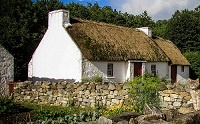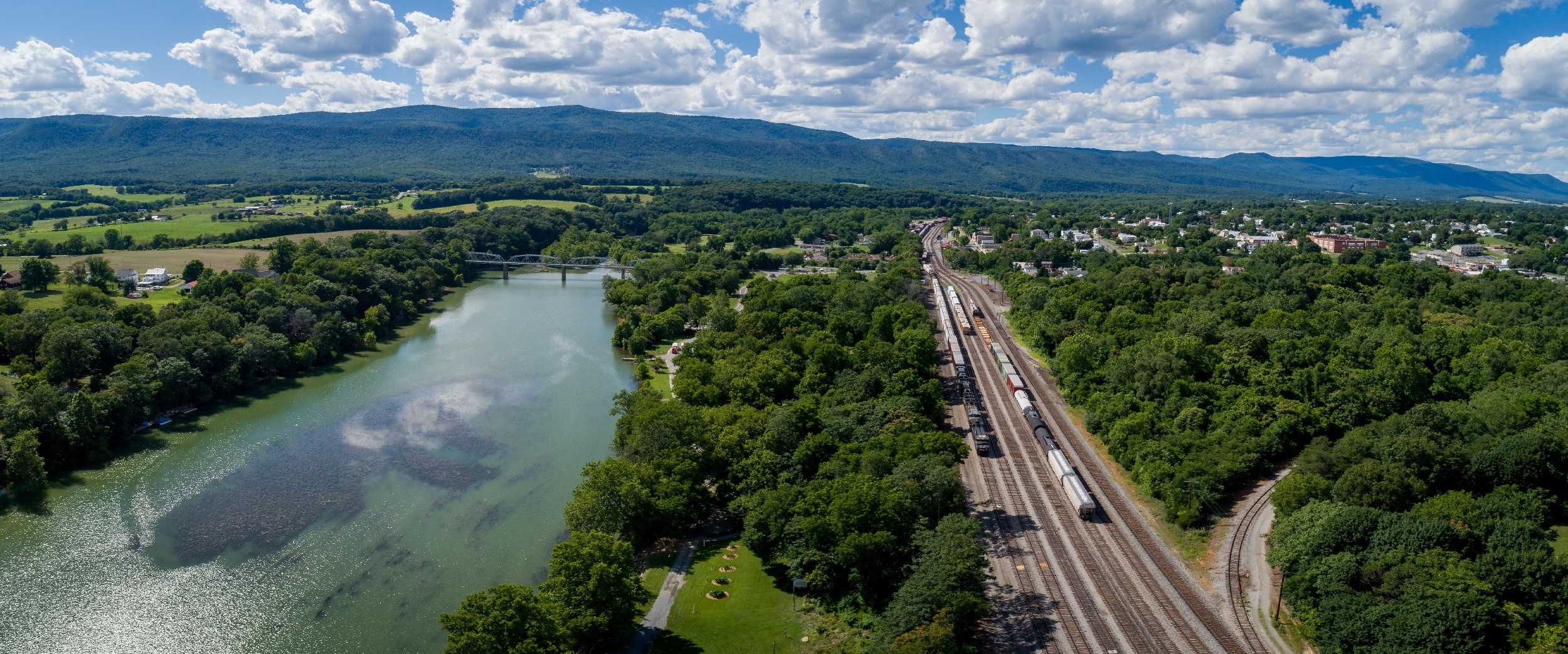The visual evidence of Virginia’s history is abundant in the Shenandoah Valley—silent Civil War battlefields, crumbling stone fences, relic cabins, and small museums housing flintlock rifles and hand -made cradles.
Early on, Virginia was the American frontier, and in the 1770s its boundaries encompassed all or parts of the current states of West Virginia, Kentucky, Indiana, Illinois, Ohio and Pennsylvania.
Early European settlers to the Valley—Germans, Swiss, Scotch-Irish and others–traveled down from the north, taking a route once called the Great Warrior Trail and eventually the Wilderness Road. Today’s Route 11 duplicates or approximates much of its course.
Modern students of American history – whether scholars or tourists—flock to the Shenandoah Valley and its rich, diverse past. An exhaustive list of iconic historical sites is beyond the scope of a short blog, but below we describe a number from different time periods that will give you a picture of the Valley’s heritage.
Martinsburg, WV
In 1861, when Belle Boyd was 17, she shot and killed a Union soldier who cursed at her mother while he was searching the Boyd home for Confederate flags. Afterwards, Boyd became a spy for the Confederates, often sending them information with the help of a servant girl, Eliza Hopewell. Today you can tour the Belle Boyd House, (126 East Race St., 304-267-4713) also serving as the Berkeley County Museum, which was built by Boyd’s father in 1853.
Harpers Ferry
In 1783, from a high cliff, Thomas Jefferson looked down at the confluence of the Potomac and Shenandoah rivers. He later wrote: “The passage of the Patowmac through the Blue Ridge is perhaps one of the most stupendous in nature.” Today, you can enjoy the same view but also tour of Harpers Ferry National Historical Park, and see the U.S. Armory and Arsenal held by John Brown and his men in 1859.
Winchester
During the Civil War, Winchester changed hands more than 70 times. The Civil War Orientation Center, located in the Winchester-Frederick County Visitors Center, is an ideal starting point to investigate Winchester’s Civil War action. Also, don’t miss Stonewall Jackson’s Headquarters. This Virginia and National Historic Landmark was used as headquarters by Jackson during the winter of 1861-1862. The house contains a large collection of Jackson memorabilia.
Near Middletown, about 20 miles south of Winchester, Cedar Creek and Belle Grove National Historical Park offers exhibits representing the history of the Shenandoah Valley, the Civil War and the 1864 Battle of Cedar Creek. Guided and self-guided tours, and interpretive ranger programs enhance this battlefield experience. Start at the Visitor Contact Station, 7712 Main Street, Middletown.
 Belle Grove Plantation (left) is one of the outstanding historic mansions in the region. At its peak, the plantation property spanned 7,500 acres. This 1797 National Historic Landmark now serves as an educational center through the many interpretive programs it offers.
Belle Grove Plantation (left) is one of the outstanding historic mansions in the region. At its peak, the plantation property spanned 7,500 acres. This 1797 National Historic Landmark now serves as an educational center through the many interpretive programs it offers.
Shenandoah National Park
Traveling the backcountry of Shenandoah National Park, you can still find traces of those who once called it home—restored  structures like Corbin Cabin in Nicholson Hollow, and stone foundations of schools, barns or houses are typical examples. Two Visitor Centers on Skyline Drive preserve much of the park’s history in photographs and memorabilia. There you can also learn about the Civilian Conservation Corps in Shenandoah. Between 1933 and 1942, they helped build the infrastructure for the park — including the construction of Skyline Drive and the overlooks, picnic grounds and developed areas along it. They also built about 100 miles of trails and planted almost 150,000 trees and shrubs. CCC camps operated in and around the park for nine years, and more than 6,500 young men passed through them.
structures like Corbin Cabin in Nicholson Hollow, and stone foundations of schools, barns or houses are typical examples. Two Visitor Centers on Skyline Drive preserve much of the park’s history in photographs and memorabilia. There you can also learn about the Civilian Conservation Corps in Shenandoah. Between 1933 and 1942, they helped build the infrastructure for the park — including the construction of Skyline Drive and the overlooks, picnic grounds and developed areas along it. They also built about 100 miles of trails and planted almost 150,000 trees and shrubs. CCC camps operated in and around the park for nine years, and more than 6,500 young men passed through them.
Front Royal
Front Royal may be best known as the northern entrance to Skyline Drive, but don’t be too quick to leave town. Two tours help visitors explore the Front Royal historic areas—the Battle of Front Royal Driving Tour follows troop movements and engagements surrounding the May 23, 1862 battle. The self-guided Walking Tour acquaints visitors with historic homes, chapels, small museums, inns, courthouses, etc. Inquire at the Front Royal Visitor Center, 414 East Main Street. Also ask about the new Greenway!
Luray/Shenandoah/Stanley
On the grounds of Luray Caverns one can also find the Luray Valley Museum, where a seven-acre collection of historic buildings has been restored to represent a small 19th century farming community. The main building displays decorative arts, items of clothing, early toys and artifacts of daily life from the 1750s to the 1920s. March 22-24 is Civil War Living History Weekend at the museum.
Just a bit south of Luray is Ed Good Park in Stanley, where a monument (part of the Blue Ridge Heritage Project) honors the Page County families who were displaced during the creation of Shenandoah National Park. And a bit south of there is the historic railroad town of Shenandoah, where a free museum (at Shenandoah Town Hall) displays photos and memorabilia from military and rail history. The town is listed on the National and State Registers of Historic Places and has more than 300 structures on the historic district listing. From a seat on First Street, railroad historians can observe the only working station between Roanoke and Hagerstown.
New Market, Edinburg, and other locales in Shenandoah County are especially rich in Civil War History. Stonewall Jackson’s troops marched through New Market no less than four times. One “must-see” stop is the Virginia Museum of the Civil War & New Market Battlefield State Historical Park. The museum concentrates on the Civil War in Virginia and displays artifacts from the Battle of New Market itself, plus photos, period firearms, etc. In this conflict, VMI cadets fought alongside of Confederate soldiers and helped defeat Union Major General Franz Sigel and his Army of the Shenandoah. Watch the moving film, “The Field of Lost Shoes,” take a self-guided tour of the 300- acre battlefield site, and reflect on this May 15, 1864 conflict.
Harrisonburg
Harrisonburg’s Visitor Center is located in the Hardesty-Higgins House at 212 S. Main St. It was the home of Harrisonburg’s first mayor, Isaac Hardesty, in the mid-1800s. Inside are the Rocktown Gift Shoppe, The Valley Turnpike Museum, The Harrisonburg-Rockingham Civil War Orientation Center and Heritage Bakery and Café. The orientation center displays a large map pinpointing major battle sites the region, a timeline of the Civil War in the Valley, as well as photos, videos and other information.
And this just in: Brand new in the Hardesty-Higgins House Visitor Center is the Virginia Craftsmen Showroom, made possible by the Swartz family. Local photographers Ashley and Ryan Swartz, along with Roy Swartz, Ryan’s father, have filled the Zirkle Library inside the Hardesty-Higgins House with unique pieces from “The Old Virginia collection,” artifacts, period catalogs and photography. Virginia Craftsmen, founded in 1927 by Walter Zirkle, Sr., still makes and retails high-quality antique reproduction furniture, crafted by hand.
Yet another, very specialized type of history is on display at Harrisonburg’s Virginia Quilt Museum, 301 S. Main Street. Antique and contemporary quilts fill three floors and are the subject of expert speakers and special exhibits all year.
Staunton
Founded in 1732, Staunton is in Augusta County (which at one time reached to the Mississippi River). Staunton is home to the Frontier Culture Museum—an absolute must for those fascinated with the Valley’s pioneer heritage. Tour 18th and 19th century  American farms, as well as those of early Europeans and Africans. Walk through an early American schoolhouse. See living history demonstrations. Attend lectures, fairs, festivals, concerts and a long list of other special events. Attend their “American Evolution” Spring Lecture Series. Take the kids to many programs for schoolchildren and toddlers. The Frontier Culture Museum is open seven days a week, 360 days each year. Hours vary by season.
American farms, as well as those of early Europeans and Africans. Walk through an early American schoolhouse. See living history demonstrations. Attend lectures, fairs, festivals, concerts and a long list of other special events. Attend their “American Evolution” Spring Lecture Series. Take the kids to many programs for schoolchildren and toddlers. The Frontier Culture Museum is open seven days a week, 360 days each year. Hours vary by season.
Staunton is also the birthplace of our 28th president, and the Woodrow Wilson Presidential Library and Museum offers guided tours of his home to illuminate what life was like in the mid- to late 19 century.
Lexington
The VMI Museum was the first public museum in the Commonwealth, and its collection preserves the heritage of Virginia Military Institute with 15,000 significant artifacts. Examples include the mounted hide of “Little Sorrel,” “Stonewall” Jackson’s favorite horse, to seven Medals of Honor awarded to VMI alumni. Many items were presented by the individuals who used them– “One of my VMI web belts Mama kept,” reads a handwritten note from General George Patton, Class of 1907.
Also in history-rich Lexington, the George C. Marshall Museum and Library allows you to tour four main areas covering the General’s life. From his youth and student life at VMI, to his long Army service and Nobel Prize in 1953, this remarkable patriot’s life is represented. Lectures, seminars and special events are held throughout much of the year.
Civil War Trails
Interpretive Civil War Trails signs may be found almost anywhere in the Valley—back roads, major highways, and hiking trails. Organizers have put decades of work and research into illuminating both major and lesser-known battle and sites of Civil War.
Find even more ways to explore the Valley’s past in our History, Culture and Museums section.
Banner photo of Corbin Cabin courtesy Neal Lewis/NPS





